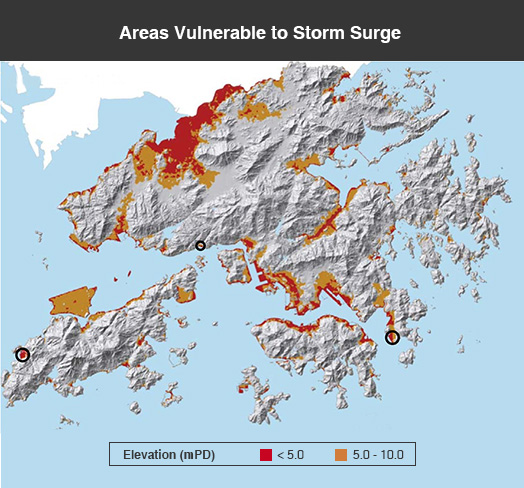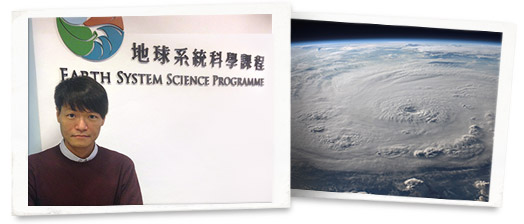The Science behind Extreme Weather, Sea Level Rise and Storm Surges
Prof. Francis Tam
Earth System Science Programme, Faculty of Science
Extreme weather events, like typhoons and torrential rainfall, can bring hazards such as landslides, tree failure, flooding and storm surges. As a coastal city with underground utilities, e.g., the MTR, Hong Kong is particularly concerned about surges and flooding, which can cause huge damage and destruction to its infrastructure.

In the territory, the most severe storm surge event in the recent decade was associated with the passage of typhoon Hagupit in 2008. This was a 1-in-50-year event, with a maximum sea level rise recorded at Tai Po Kau of 3.77 m. The event led to flooding in many low-lying areas, including Tai O, Sham Tseng and Lei Yue Mun. In 1962 typhoon Wanda brought even larger surges, with a maximum amplitude of 3.96 m. How do we understand these extreme events based on physical science, and how will they change in the future under a warmer climate?
Typhoons as Heat Engines
It is indisputable that man-made greenhouse gas emission causes global warming, and the warming of global oceans is an expected result. Warmer sea surface temperature can provide more energy to ‘fuel’ tropical cyclones. In fact, tropical cyclones work just like a heat engine; the amount of heat energy it can take from the Earth system is proportional to the surface temperature of warm tropical oceans, minus the air temperature at a certain height up in the atmosphere. It follows that the maximum intensity of a tropical cyclone depends on the temperature of the sea surface.

As to sea level changes, they are due to fluctuations of winds and of the ocean circulation itself, vertical land displacements, and changes of the ocean floor height. Under global warming, sea level rise is also attributed to thermal expansion of the ocean, mass loss of ice sheets/glaciers and the resulting modification of the Earth's gravitational field. Historically over the South China Sea, based on satellite measurements from the 1980s to the present, the rate of sea level rise is about 5 to 6 mm per year. In Hong Kong, measurements at Tai Po Kau give a rate of about 5 mm per year.
For storm surges, both the storm wind speed and the geometry of the ocean basin are important in determining their amplitudes. Roughly speaking, the storm surge height is proportional to the square of the wind speed divided by the depth of water. Therefore, continental shelves with shallow area give larger surges. In reality, complex coastlines and basin geometries make predictions or simulations of surges and movement of water particularly challenging. The size of a tropical cyclone is also important. Larger storms produce stronger surges; Sandy in the US is an example. Finally the track of a tropical cyclone also determines the surge height. In Hong Kong, due to shielding effect of nearby mountains, the territory experiences the strongest winds when a tropical cyclone is located to its south or south-east.
Future Projections: Warmer and Higher Seas
So, what are the future projections of extreme sea level under a warmer climate? Firstly, studies show that tropical cyclone wind speed increases about 4% per degree rise of the sea surface temperature. Because storm surge amplitudes go with the square of wind speed, it means 8% increase of surge height per degree warming of tropical oceans. If the world’s ocean warms by 4°C, then storm surge amplitudes will increase by about 30% due to changes of storm characteristics.
Most important, however, will be the effect of sea level rise and perhaps land subsistence. For the greenhouse gas emission scenario called Representative Concentration Pathway (RCP) 8.5, it is projected that in 2100, the sea level near Hong Kong Waters will rise by as much as 100 cm relative to its present value. This represents a large increase of the baseline sea level and has huge implications. Because of such an increase, and due to this factor alone, surges comparable to those caused by typhoon Hagupit will become more and more frequent: a 50-year event for the present climate will become one that happens basically every year in 2100.


We still cannot exactly pinpoint the increase of storm surge risk in Hong Kong due to global warming. For one thing, we simply cannot predict the ‘human factor’—our dependence on fossil fuels in the future will depend on our lifestyles and advances in technology. For another, from the perspective of a physical scientist, a lot more research needs to be done to understand how tropical cyclone tracks, wind circulation and temperature profile will change under a warmer climate. This author is currently collaborating with the Hong Kong Observatory in investigating these issues.


